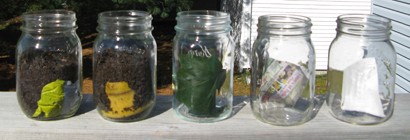For teachers, youth group leaders, or day-care supervisors, here are some simple experiments which will help your kids understand how composting helps the earth and plants. You won't need much in the way of equipment, and the results are fun to watch.
How does compost help growing plants?
Activity
- Soak six or eight beans overnight in water.
- Fill one jar or flowerpot with ordinary soil dug up from your garden, lawn, or pathway.
- Fill a second jar or pot with the same kind of soil, but mix it half-and-half with finished compost. If you don't have a compost pile yet, you can use composted manure from a garden centre.
- Plant a few beans in each pot.
- Place them where they will be warm and have some sunshine.
- Keep the pots watered, and check each day to see what happens.
Soils that contain lots of decomposed organic matter, like compost, can store more food for the plants and release it to them as they need it. Unless you are lucky enough to have very rich soil already, you'll probably find that the beans grew faster and stronger in the pot that had compost added to the soil.
How does compost help soil structure?
Activity
- Find two wide-mouthed glass containers (mayonnaise jars are perfect).
- Make two small baskets or wire racks of quarter-inch screen. For each rack you will need a piece of screen about 7.5 cm by 25 cm (3 inches by 10 inches). Bend the wire so that it fits down into the jars like a little basket.
- Find a place where the soil is very light in colour, like a construction site or a heavily farmed field. Collect several clumps of soil about the size of a fist.
- Collect a second sample of soil clumps from dark earth, such as a garden that has been fed regularly with compost, or a park.
- Fill the jars with water within 2.5 cm (one inch) of the top.
- Place the lumps of soil in the baskets and lower them gently into the jars. Watch closely!
Why does the soil in one basket fall apart and drop to the bottom of the jar? Organic matter, like decomposed leaves and roots, helps soil hold water and air. When organic matter is used up, we have to give nature time to replace it, or feed the earth with compost. When earth holds together like this, it can stand the hard rains that wash away less healthy soil.
Can everything be turned into compost?
Activity
- Find four or five widemouthed glass jars. You'll want to be able to see through the sides of them.
- Collect a banana skin or apple core, a scrap of newspaper, a leaf (green or brown), and a piece of plastic. There may be other things you want to test as well.
- Place each of these items in a separate jar. Hold them close to the side, where you can see them, and fill the jars with ordinary soil.
- Don't cover the jars, but make sure the soil covers your samples.
- Water every day, just enough to keep the soil damp. Don't let it dry out or freeze.
- Watch what happens, or doesn't happen, in each jar.
You'll soon notice changes in some of your samples as they start to decompose. Some change faster than others, and the piece of plastic won't change at all! Anything that once came from a living thing is called "organic" and will break down. You can use these to make compost. What do you think happens to all these things when they're taken away by the garbage collector and buried in a landfill?

